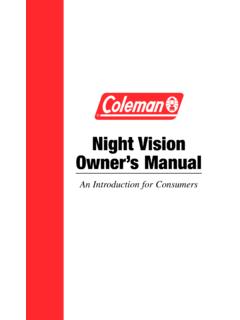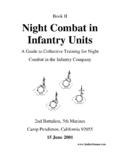Transcription of Night Vision Goggles - NVG Safety 2
1 7. Night Vision Goggles Dennis L. Schmickley Introduction Boeing Helicopter Co. NVG as Part of the Avionics Suite What Are NVG? History of NVG in Aviation Fundamentals 2. Theory of Operation I Amplification of the Night Scene . 2. NVG Does Not Work without Compatible Lighting! I. Integration into Aircraft Applications and Examples Gen III and AN/AVS-6 ANVIS Gen II and AN/PVS-5 NVG Cat's Eyes NVG HUD ANVIS. HUD Panoramic NVG Low Profile NVG Integrated I 2 Systems Testing and Maintaining the NVG Lighting Design Considerations Types of Filters/Lighting Sources Evaluating Aircraft Lighting Measurement Equipment Nighttime Illumination Moon phases NVG in Civil Aviation References Further Information Introduction NVG as Part of the Avionics Suite Visual reference to the aviator's outside world is essential for safe and effective flight.
2 During the daylight hours and in visual meteorological conditions (VMC), the pilot relies heavily on the out-the-windshield view of the airspace and terrain for situational awareness. In addition, the pilot's visual system is aug- mented by the avionics which provide communication, navigation, flight control, mission, and aircraft systems information. During nighttime VMC, the pilot can improve the out-the-windshield view with the use of Night Vision Goggles (NVG). NVG lets the pilot see in the dark during VMC conditions! This chapter deals with NVG for aviation applications. There are many various nonaviation applica- tions of NVG that are not addressed herein: NVG for personnel on the ground or underwater, and for ground vehicles and sea vehicles.
3 What Are NVG? 2. NVG are light image intensification (I ) devices that amplify the Night -ambient-illuminated scenes by a factor of 104. For this application light includes visual light and near infrared. The development of the microchannel plate (MCP) allowed miniature packaging of image intensifiers into a small, lightweight, helmet-mounted pair of Goggles . With the NVG, the pilot views the outside scene as a green phosphor image displayed in the eyepieces. 2001 by CRC Press LLC. Various terms are associated with NVG type equipment: 2. NVG general term of any I device, usually head-worn and binocular 2.
4 I Image Intensifier type of sensor device used in NVG. ANVIS Aviator's Night Vision Imaging System; a type of NVG designed for aviators NVIS Night Vision Imaging System; a general class of NVG including ANVIS. Gen II Second-generation intensifier technology utilizing MCP and multi-alkali photocathode which enabled construction of AN/PVS-5 NVG. Gen III Third-generation intensifier technology utilizing improved MCP and galium arsenide pho- tocathode which enabled construction of AN/AVS-6 ANVIS. NVG HUD Night Vision Goggle with a Head-Up Display attached HMD Helmet-Mounted Display; in this chapter it includes NVG HUD.
5 PNVG Panoramic Night Vision Goggle; usually about 100 FOV. LPNVG Low-Profile Night Vision Goggle; usually conforms to face AGC Automatic gain control History of NVG in Aviation 1950s In the 1950s there was considerable and diverse research on Night image intensification as reported at the Image Intensifier The applications included devices for military sensing and for astron- omy and scientific research, but were not directed specifically to head-mounted pilotage devices. The Army first experimented with T-6A infrared driving binocular in helicopters in the late 1950s, according to Jenkins and The binocular device was a near infrared (IR) converter which required an IR filtered landing light for the radiant energy, and was not satisfactory for aviation.
6 In the late 1950s, the first continuous-channel electron multiplier research was being conducted at the Bendix Research Laboratories by George Goodrich, James Ignatowski, and William Wiley. The invention of the continuous-channel multiplier was the key step in the development of the microchannel plate (Lampton1). 1960s 2. In the early 1960s first-generation I tubes were developed. The tubes allowed operation as a passive system, 2. but the size of the three-stage I tubes was too large for head-mounted applications. Passive refers to needing no active projected illumination; the system can operate using the ambient starlight illumination, thus the name starlight scope from the Vietnam era foot soldier's sniper scope.
7 In the late 1960s, the production of 2. the microchannel plates, used in the second-generation wafer technology I tubes, allowed Night Vision devices to be packaged small enough and light enough for head-mounted applications. Thus, in the late 1960s and 2. early 1970s the Army Night Vision and Electro-Optics Laboratory (NV&EOL) used Gen II I tubes to develop NVGs for foot soldiers, and some of these NVGs were tried by aviators for Night flight operations. 1970s In 1971 the USAF began limited use of the SU-50 Electronic Binoculars. In 1973 the Army adopted the Gen II AN/PVS-5 as an interim NVG solution for aviators, although there were known deficiencies in low-light-level performance, weight, visual facemask obstruction, and refocusing (due to incompatibility with cockpit lighting systems).
8 The aviator's Night Vision imaging system (ANVIS) was the first NVG. developed specifically to meet the visual needs of the aviator. The NV&EOL started ANVIS development in 1976 utilizing third-generation image intensifier technology and requiring high-performance, light- weight, and improved reliability and maintainability. 1980s Two versions of the ANVIS were introduced into military aviation: AN/AVS-6(V)1 for most helicopters; fits onto the helmet with a centerline mount. AN/AVS-6(V)2 for AH-1 Cobra only; fits onto the helmet with an offset mount. 2001 by CRC Press LLC. ANVIS operation would not have been feasible or safe in the aircraft if the cockpit lighting had remained the traditional red-lighted or white-lighted incandescent illumination.
9 In 1981 the Army released an Aeronautical Design Standard, ADS-23,5 to establish baseline requirements for development of cockpit lighting to be compatible with ANVIS. In 1986 the Joint Aeronautical Commanders Group (JACG) released a Tri-Service specification, MIL-L-85762,7 which defined standards for designing and measuring ANVIS-compatible lighting. GEC-Marconi introduced a Gen III projected view NVG, called the Cat's Eye for use in the AV-8 Harrier. An updated MIL-L-85762A8 was released in 1988 in which it defined NVIS as a general term (replacing the specific ANVIS term) and expanded the lighting requirements to accommodate various type NVIS.
10 The controversial utilization of the AN/PVS-5 continued in aviation pending full fielding of ANVIS. Based upon a series of nighttime accidents often involving NVGs, a Congressional Hearing was convened (1989). to review the Safety and appropriateness of NVGs in military helicopters. ANVIS was deemed necessary. 1990s Head-up flight information symbology was desired, along with the out-the-window view, within the NVG. Integrating the symbology and imagery resulted in a new type of helmet-mounted display (HMD). referred to as the NVG HUD . Two types of NVG HUDs were placed in service: AN/AVS-7 NVG HUD was installed on CH-47D and HH-60 aircraft.






